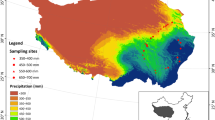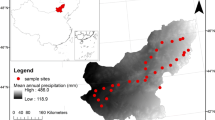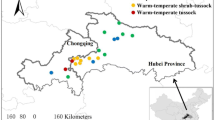Abstract
Background
Soil is an important organic carbon (C) pool in terrestrial ecosystems, but knowledge on soil organic carbon (SOC) decomposition rate and influencing factors remains limited, particularly in arid and semi-arid grasslands. Models show that global semi-arid regions are experiencing more extreme climate events, which may trigger more C loss from soils.
Methods
We used the stable carbon isotope (δ13C) of plant and soil depth profile to examine decomposition rates of SOC along a 2200 km semi-arid grassland transect in northern China. Beta (β) was calculated from the relationship between δ13C and C concentrations of plant and soil profile (0–100 cm). Partial correlation analysis and structure equation models were used to analyze correlations between beta and climatic and edaphic variables.
Results
We found that the δ13C values increased from plant tissues to surface soil and then deep soil at all sites, while the SOC concentration decreased. The β values ranged from −0.33 to −2.27, with an average value at −1.37. There was a positive correlation between β value and SOC decomposition rate constant (k), supporting the hypothesis that enrichment of δ13C along soil depth profile was mainly due to isotopic fractionation during microbial SOC decomposition. The correlation between β value and aridity index was mainly due to the variations of edaphic properties such as soil C/N ratio with aridity index, pointing to the more important role of edaphic properties in β value than climatic factors.
Conclusions
Despite uncertainties associated with the interpretation of soil δ13C along its depth profile, our results demonstrated that soil δ13C could provide an independent benchmark for examining model-based predictions of SOC decomposition in semi-arid grasslands. Incorporation of both climatic and edaphic variables into models may enhance the predictions for SOC dynamics under global climate changes.



Similar content being viewed by others
Abbreviations
- N:
-
Nitrogen
- C:
-
Carbon
- SOC:
-
Soil organic carbon
- SOM:
-
Soil organic matter
- MAP:
-
Mean annual precipitation
- MAT:
-
Mean annual temperature
- AI:
-
Aridity index
- PET:
-
Potential evaportranspiration
- SEMs:
-
Structure equation models
Reference
Accoe F, Boeckx P, Cleemput OV, Hofman G, Zhang Y, Guanxiong C (2002) Evolution of the δ13C signature related to total carbon contents and carbon decomposition rate constants in a soil profile under grassland. Rapid Commun Mass Sp 16:2184–2189
Acton P, Fox J, Campbell E, Rowe H, Wilkinson M (2013) Carbon isotopes for estimating soil decomposition and physical mixing in well-drained forest soils. J Geophys Res Biogeosci 118:1532–1545
Anderson JM (1991) The effects of climate change on decomposition processes in grassland and coniferous forests. Ecol Appl 1:326–347
Balesdent J, Girardin C, Mariotti A (1993) Site related 13C of tree leaves and soil organic matter in a temperate Forest. Ecology 74:1713–1721
Bird MI, Chivas AR, Head J (1996) A latitudinal gradient in carbon turnover times in forest soils. Nature 381:143–146
Boström B, Comstedt D, Ekblad A (2007) Isotope fractionation and 13C enrichment in soil profiles during the decomposition of soil organic matter. Oecologia 153:89–98
Brunn M, Spielvogel S, Sauer T, Oelmann Y (2014) Temperature and precipitation effects on δ13C depth profiles in SOM under temperate beech forests. Geoderma 235-236:146–153
Campbell JE, Fox JF, Davis CM, Rowe HD, Thompson N (2009) Carbon and nitrogen isotopic measurements from southern Appalachian soils: assessing soil carbon sequestration under climate and land-use variation. J Environ Eng 135:439–448
Carvalhais N, Forkel M, Khomik M, Bellarby J, Jung M, Migliavacca M, Mu M, Saatchi S, Santoro M, Thurner M, Weber U, Ahrens B, Beer C, Cescatti A, Randerson JT, Reichstein M (2014) Global covariation of carbon turnover times with climate in terrestrial ecosystems. Nature 514:213–217
Delgado-Baquerizo M, Maestre FT, Gallardo A, Bowker MA, Wallenstein MD, Quero JL, Ochoa V, Gozalo B, García-Gómez M, Soliveres S (2013) Decoupling of soil nutrient cycles as a function of aridity in global drylands. Nature 502:672–676
Desjardins T, Andreux F, Volkoff B, Cerri C (1994) Organic carbon and 13C contents in soils and soil size-fractions, and their changes due to deforestation and pasture installation in eastern Amazonia. Geoderma 61:103–118
Dijkstra FA, Augustine DJ, Brewer P, von Fischer JC (2012) Nitrogen cycling and water pulses in semiarid grasslands: are microbial and plant processes temporally asynchronous? Oecologia 170:799–808
Diochon A, Kellman L (2008) Natural abundance measurements of 13C indicate increased deep soil carbon mineralization after forest disturbance. Geophys Res Lett 35:L14402
Doetterl S, Stevens A, Six J, Merckx R, Van Oost K, Casanova Pinto M, Casanova-Katny A, Munoz C, Boudin M, Zagal Venegas E, Boeckx P (2015) Soil carbon storage controlled by interactions between geochemistry and climate. Nat Geosci 8:780–783
Ehleringer JR, Buchmann N, Flanagan LB (2000) Carbon isotope ratios in belowground carbon cycle processes. Ecol Appl 10:412–422
Enríquez S, Duarte CM, Sand-Jensen K (1993) Patterns in decomposition rates among photosynthetic organisms: the importance of detritus C: N: P content. Oecologia 94:457–471
Feng J, Turner BL, Lü XT, Chen ZH, Wei K, Tian JH, Wang C, Luo WT, Chen LJ (2016) Phosphorus transformations along a large-scale climosequence in arid and semiarid grasslands of northern China. Global Biogeochem Cy 30:1264–1275
Flanagan LB, Brooks JR, Varney GT, Berry SC, Ehleringer JR (1996) Carbon isotope discrimination during photosynthesis and the isotope ratio of respired CO2 in boreal forest ecosystems. Global Biogeochem Cy 10:629–640
Fontaine S, Barot S, Barré P, Bdioui N, Mary B, Rumpel C (2007) Stability of organic carbon in deep soil layers controlled by fresh carbon supply. Nature 450:277–280
Friedli H, Siegenthaler U, Rauber D, Oeschger H (1987) Measurements of concentration, 13C/12C and 18O/16O ratios of tropospheric carbon dioxide over Switzerland. Tellus B 39:80–88
Garten CT, Hanson PJ (2006) Measured forest soil C stocks and estimated turnover times along an elevation gradient. Geoderma 136:342–352
Garten CT, Cooper LW, Post WM III, Hanson PJ (2000) Climate controls on forest soil C isotope ratios in the southern Appalachian Mountains. Ecology 81:1108–1119
Harris D, Horwáth WR, van Kessel C (2001) Acid fumigation of soils to remove carbonates prior to total organic carbon or carbon-13 isotopic analysis. Soil Sci Soc Am J 65:1853–1856
Hijmans RJ, Cameron SE, Parra JL, Jones PG, Jarvis A (2005) Very high resolution interpolated climate surfaces for global land areas. Int J Climatol 25:1965–1978
Kohl L, Laganière J, Edwards KA, Billings SA, Morrill PL, Van Biesen G, Ziegler SE (2015) Distinct fungal and bacterial δ13C signatures as potential drivers of increasing δ13C of soil organic matter with depth. Biogeochemistry 124:13–26
Lal R (2004) Carbon sequestration in dryland ecosystems. Environ Manag 33:528–544
Luo WT, Sardans J, Dijkstra FA, Peñuelas J, Lü XT, Wu HH, Li MH, Bai E, Wang ZW, Han XG, Jiang Y (2016) Thresholds in decoupled soil-plant elements under changing climatic conditions. Plant Soil 409:1–15
Nadelhoffer K, Fry B (1988) Controls on natural nitrogen-15 and carbon-13 abundances in forest soil organic matter. Soil Sci Soc Am J 52:1633–1640
Nielsen UN, Ball BA (2015) Impacts of altered precipitation regimes on soil communities and biogeochemistry in arid and semi-arid ecosystems. Glob Chang Biol 21:1407–1421
Poage MA, Feng XH (2004) A theoretical analysis of steady state δ13C profiles of soil organic matter. Global Biogeochem Cy 18:GB2016. doi:10.1029/2003GB002195
Powers JS, Schlesinger WH (2002) Geographic and vertical patterns of stable carbon isotopes in tropical rain forest soils of Costa Rica. Geoderma 109:141–160
Reed SC, Coe KK, Sparks JP, Housman DC, Zelikova TJ, Belnap J (2012) Changes to dryland rainfall result in rapid moss mortality and altered soil fertility. Nat Clim Chang 2:752–755
Reynolds JF, Smith DMS, Lambin EF, Turner B, Mortimore M, Batterbury SP, Downing TE, Dowlatabadi H, Fernández RJ, Herrick JE (2007) Global desertification: building a science for dryland development. Science 316:847–851
Schweizer M, Fear J, Cadisch G (1999) Isotopic (13C) fractionation during plant residue decomposition and its implications for soil organic matter studies. Rapid Commun Mass Sp 13:1284–1290
Staddon PL (2004) Carbon isotopes in functional soil ecology. Trends Ecol Evol 19:148–154
Torn MS, Lapenis AG, Timofeev A, Fischer ML, Babikov BV, Harden JW (2002) Organic carbon and carbon isotopes in modern and 100 year old soil archives of the Russian steppe. Glob Chang Biol 8:941–953
Wang C, Wang XB, Liu DW, Wu HH, Lü XT, Fang YT, Cheng WX, Luo WT, Jiang P, Shi J, Yin HQ, Zhou JZ, Han XG, Bai E (2014) Aridity threshold in controlling ecosystem nitrogen cycling in arid and semi-arid grasslands. Nat Commun 5:4799. doi:10.1038/ncomms5799
Wang C, Liu DW, Luo WT, Fang YT, Wang XB, Lü XT, Jiang Y, Han XG, Bai E (2016) Variations in leaf carbon isotope composition along an arid and semi-arid grassland transect in northern China. J Plant Ecol 9:576–585
Wynn JG, Harden JW, Fries TL (2006) Stable carbon isotope depth profiles and soil organic carbon dynamics in the lower Mississippi Basin. Geoderma 131:89–109
Xu X, Shi Z, Li D, Rey A, Ruan HH, Craine JM, Liang JY, Zhou JZ, Luo YQ (2016) Soil properties control decomposition of soil organic carbon: results from data-assimilation analysis. Geoderma 262:235–242
Yang YH, Ji CJ, Chen LY, Ding JZ, Cheng XL, Robinson D (2015) Edaphic rather than climatic controls over 13C enrichment between soil and vegetation in alpine grasslands on the Tibetan plateau. Funct Ecol 29:839–848
Acknowledgements
We thank two anonymous reviewers for useful comments on an earlier version of the manuscript. This work was financially supported by Major State Basic Research Development Program of China (973 Program, 2014CB954400), the National Natural Science Foundation of China (31522010 and 41601255), and Key Research Program of Frontier Sciences, CAS (QYZDB-SSWDQC006). We gratefully acknowledge all members of the Shenyang Sampling Campaign Team from the Institute of Applied Ecology, Chinese Academy of Sciences for their assistance during field sampling.
Author information
Authors and Affiliations
Corresponding author
Additional information
Responsible Editor: Ingrid Koegel-Knabner.
Electronic supplementary material
ESM 1
(DOCX 2.12 mb)
Rights and permissions
About this article
Cite this article
Wang, C., Wei, H., Liu, D. et al. Depth profiles of soil carbon isotopes along a semi-arid grassland transect in northern China. Plant Soil 417, 43–52 (2017). https://doi.org/10.1007/s11104-017-3233-x
Received:
Accepted:
Published:
Issue Date:
DOI: https://doi.org/10.1007/s11104-017-3233-x




